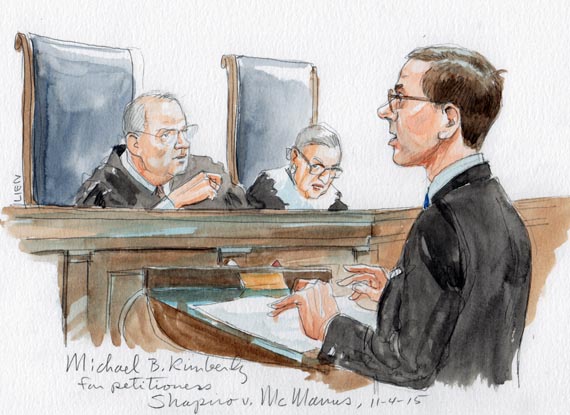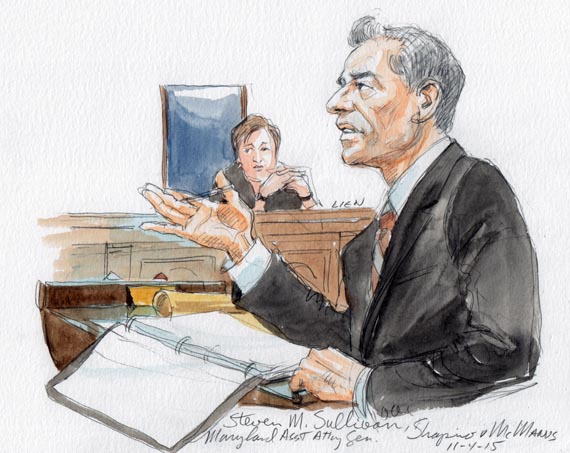Conflicted Court Likely to Reverse 4th Circuit in Maryland Redistricting Case
March 2, 2016
By: Hayley Steffen
The stakes were high at oral argument for Shapiro v. McManus on November 4, 2015. Justice Breyer said Shapiro and his co-plaintiffs “want[ed] to raise about as important a question as you can imagine . . . And if they [were] right, that would affect congressional districts and legislative districts throughout the nation.” It was clear that the justices struggled with the serious implications that their decision could have for future redistricting and partisan gerrymandering cases.
In Shapiro v. McManus, a group of Maryland citizens brought suit challenging the state’s contorted congressional districts, drawn by Democrats in 2011. Petitioners claimed that the political map violated Republicans’ First Amendment rights “by placing them in districts where they were the minority, therefore marginalizing them based on their political views.” Although the petitioners requested a three-judge panel to rule on the case pursuant the Three-Judge Court Act, 28 U.S.C §2284, a single-judge district court dismissed the case for failure to state a claim under Federal Rule of Civil Procedure 12(b)(6). As a result, the question before the justices was whether a single district court judge could dismiss the case under Rule 12(b)(6), or whether a three-judge panel had to review the case. Because appeals of cases heard by three-judge panels are mandatorily reviewable by the Supreme Court, the stakes are high for the petitioners, as well as the Justices. (For more background about the Three-Judge Act and the issue in the case, see my previous post).
Although oral argument was unusually sleepy, the questions the justices raised reflected the two conflicting interests at issue in the case. On the one hand, the justices clearly valued Congress’ recognition that election law claims are so important that the procedures must be expedited and therefore heard by a three-judge panel. Yet, on the other hand, a ruling in favor of petitioners could draw the Court dangerously close (or even into) the “political thicket,” forcing them to hear partisan gerrymandering cases. Partisan gerrymandering claims have been off the table for Supreme Court review since the ruling in Vieth v. Jubelirer, when the Court arguably decided that such claims were not justiciable because of their political nature. However, as some of the justices aptly recognize, a ruling in petitioners’ favor could force more cases to be heard by three-judge panels with greater access to Supreme Court review through direct appeal. While the Court does not have to hear these cases, rejecting a case means the lower court did get it right, putting more pressure on the Justices to actually hear the case.

On behalf of the voters, Mayer Brown LLP associate Michael B. Kimberly argued that the district court applied the wrong standard in refusing to send the case to a three-judge panel. According to Kimberly, a single-judge district court can dismiss a complaint only when it is “obviously frivolous” or “wholly insubstantial.” A single judge can dismiss a claim only when Supreme Court precedent undisputedly forecloses it. Because dismissing a case based on Rule 12(b)(6) requires an inquiry into the merits of a case, and therefore far beyond the threshold of “obviously frivolous,” the district court clearly erred. Yet, a dubious Chief Justice Roberts said that’s an “awfully fuzzy line” to draw, a single judge can’t dismiss “just because the plaintiffs are wrong, but he can make that determination if they are really wrong?” Using the Chief Justice’s discomfort to his advantage, Kimberly argued that if the court wants a clear rule, it should require all merits questions to be decided by a three-judge panel.
Arguing for the state of Maryland, Steven M. Sullivan faced fewer questions, but more skepticism from some justices. Sullivan contended that the historic practice of single judge dismissals justified dismissal in this case. Justice Kagan asked Sullivan if he was changing his argument from his brief, where he argued that the 1976 amendments to the Three-Judge Act narrowed the scope of the law justifying the dismissal. Sullivan replied that he was just responding to the petitioners’ argument, but a tough Justice Scalia commented that the point should have been in his brief. Furthermore, Justice Kagan challenged Sullivan’s argument that the difference between insubstantiality and failure to state a claim “is not borne out.” Kagan averred that claims in this area have always sounded “merits-y,” but have been reserved for claims that are “completely ridiculous.”
Sullivan was able finish the argument on a strong note by raising the issue that makes this case so controversial: the direct appeal to the Supreme Court from a three-judge panel ruling. Chief Justice Roberts seemed especially concerned, stating that’s “a serious problem because there are a lot of cases that come up in three-judge district courts that would be the kind of case—I speak for myself, anyway—that we might deny cert. in, to let the issue percolate. And now with the three-judge district court, no, we have to decide it on the merits.” Justice Breyer seconded the Chief Justice’s concerns, fearing that the Court would have no choice but to hear the “specially political” cases heard in front of three-judge panels. Breyer said, “that set of cases where we should be particularly carefully as to how to proceed will be the set of cases where we have no choice and we have to take immediately…” Being particularly uncomfortable in ruling on political issues, the Chief Justice and Justice Breyer’s concerns could weigh heavily on a decision in the case.
Despite the serious implications involved in this case, many have nonetheless predicted that the Court will unanimously rule in favor of the voters. While the Court is likely to reverse the 4th Circuit’s decision, the justices’ obvious discomfort in being forced to rule in partisan gerrymandering cases may make this a closer call than anticipated.
